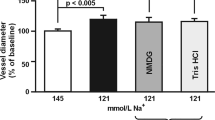Abstract
The present experiments were undertaken to define changes in tissue calcium metabolism in focal and perifocal (“penumbral”) tissues following 2 h of transient middle cerebral artery occlusion (MCAO) in rats, induced with an intraluminal filament occlusion technique. The extracellular calcium concentration ([Ca2+]e) was measured with ion-selective microelectrodes in neocortical focus and penumbra. For measurement of total tissue calcium content, tissue samples from these areas were collected and analyzed with atomic absorption spectrometry. During MCAO, [Ca2+]e in a neocortical focal area fell from a normal value of about 1.2 mM to values around 0.1 mM, suggesting translocation of virtually all extracellular calcium to intracellular fluids. Recirculation was accompanied by re-extrusion of calcium within 5–7 min; however, [Ca2+]e never returned to normal but stabilized at about 50% of the control value for the first 6 h, and decreased further after 24 h. In penumbral areas, [Ca2+]e showed the expected transient decreases associated with spreading depression-like (or ischemic) depolarization waves. Recirculation was followed by return of [Ca2+]e towards normal values. In the focus, water content increased from about 79% to about 80.4% at the end of the 2-h period of ischemia. After 2 h and 4 h of recirculation, the edema was aggravated (mean values 81.9% and 81.2%, respectively). After 6 h and 24 h, the edema was more pronounced (83.6% and 83.8%, respectively). In the penumbra, no significant edema was observed until 6 h and 24 h of recirculation. The total tissue calcium content in the focus (expressed by unit dry weight) increased at the end of the ischemia period demonstrating calcium translocation from blood to tissue. After 6 h and 24 h, the content increased two- to threefold, compared with control. Changes in the penumbra were qualitatively similar but less pronounced, and a significant increase was not observed until after 6 h of recirculation. The results suggest that 2 h of MCAO leads to a profound perturbation of cell calcium metabolism. In focal areas, cells fail to extrude the calcium that is gradually accumulated during reperfusion and show massive calcium overload after the first 4–6 h of recirculation. Penumbral tissues show a similar increase in calcium concentration after 6 h of recirculation.
Similar content being viewed by others
Author information
Authors and Affiliations
Additional information
Received: 2 June 1997 / Accepted: 26 November 1997
Rights and permissions
About this article
Cite this article
Kristián, T., Gidö, G., Kuroda, S. et al. Calcium metabolism of focal and penumbral tissues in rats subjected to transient middle cerebral artery occlusion. Exp Brain Res 120, 503–509 (1998). https://doi.org/10.1007/s002210050424
Issue Date:
DOI: https://doi.org/10.1007/s002210050424




